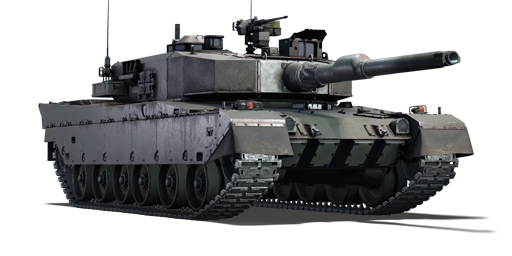

Ground Vehicles
Type 90 (B)
VII
Rank
AB
11.7
RB
11.7
SB
11.7
Battle rating
Japan
Research country
Medium tank
Main role
175,000

Research
950,000

Purchase
General information
The Type 90(B) MBT is a specialized variant of the Type 90 MBT, designed to mount a Type 92 minefield-clearing roller at the front of the vehicle. Unlike the standard Type 90, which can be equipped with a dozer blade, the Type 90(B) cannot mount a dozer, as the attachment points for the roller interfere with the dozer configuration.
It was introduced in Update 1.95 "Northern Wind". Essentially a backup to the standard Type 90, it offers the same formidable 4-second autoloaded 120 mm gun firing JM33 rounds, strong mobility, and average armour for an MBT. The only significant difference is the addition of 10 mm mounting plates on the lower front plate, which prevents the attachment of a dozer blade.
Camouflages
Survivability and armour
Armour
front / side / back
Hull
40 / 35 / 25 mm
Turret
35 / 80 / 25 mm
Visibility
95 %
Crew
3 persons
Support systems
Mobility
Max speed
Forward
7381 km/h
Backward
3438 km/h
Power-to-weight ratio
29.926.449.840.5 hp/t
Engine power
1,5001,3272,5022,032 hp
Weight
50.2 t
Optics
Gunner
Commander
Driver
Optics zoom
8.8x–10.0x
3.0x–10.0x
—
Optical device
Armaments
120 mm Type 90 L/44 cannon
Ammunition
40 rounds
First-order
18 rounds
Reload
4 s
Vertical guidance
-7 / 10°
Turret Rotation Speed
basic crew → aces
Horizontal
2117.939.528.6 → 3025.556.540.8 °/s
Vertical
75.624.515.7 → 1083522.4 °/s
| Ammunition | Type | Armor penetration (mm) at a distance: | |||||
|---|---|---|---|---|---|---|---|
| 10 m | 100 m | 500 m | 1000 m | 1500 m | 2000 m | ||
| HEATFS | 480 | 480 | 480 | 480 | 480 | 480 | |
| APFSDS | 481 | 480 | 472 | 462 | 451 | 441 | |
12.7 mm M2HB machine gun
Ammunition
600 rounds
Belt capacity
100 rounds
Reload
basic crew → aces
10.4 → 8 s
Fire rate
575 shots/min
Vertical guidance
-8 / 60°
Horizontal guidance
-120 / 120°
Turret Rotation Speed
basic crew → aces
Horizontal
6353.6118.685.7 → 9076.5169.4122.4 °/s
Vertical
6350.4220.5141.1 → 9072315201.6 °/s
| Belt | Belt filling | Armor penetration (mm) at a distance: | |||||
|---|---|---|---|---|---|---|---|
| 10 m | 100 m | 500 m | 1000 m | 1500 m | 2000 m | ||
| API-T/I/AP/API-T | 31 | 29 | 21 | 14 | 9 | 6 | |
7.62 mm Type 74 machine gun (coaxial)
Ammunition
4,500 rounds
Belt capacity
250 rounds
Reload
basic crew → aces
10.4 → 8 s
Fire rate
700 shots/min
| Belt | Belt filling | Armor penetration (mm) at a distance: | |||||
|---|---|---|---|---|---|---|---|
| 10 m | 100 m | 500 m | 1000 m | 1500 m | 2000 m | ||
| AP/AP/T | 13 | 12 | 7 | 3 | 2 | 0 | |
Economy
Repair cost
Basic → Reference
AB
4,508 → 6,708 

RB
4,456 → 6,631 

SB
5,447 → 8,105 

Crew training
270,000 

Experts
950,000 

Aces
2,200 

Research Aces
1,210,000 

Reward multiplier
AB / RB / SB
150 / 190 / 220 % 

244 % 

Total cost of modifications
272,900 

456,000 

Talisman cost
3,000 

Research order:
Mobility | |
|---|---|
Protection |
|---|
Firepower | ||
|---|---|---|
Rating by players
You must play more than 3 battles for the last week and more than 10 battles in a vehicle to rate it.
Like:
33
Armor protection:
Not enough ratings
Survivability:
Not enough ratings
Mobility:
Not enough ratings
Armament:
Not enough ratings
Balance:
Not enough ratings
Tips & Tricks
This space is currently empty
Do you know any interesting vehicle features?
Loading...
No articles about this vehicle yet
Become the first author and get rewards!
Write a guide, tell about interesting historical facts, make a tutorial or simply an interesting post.
No more content